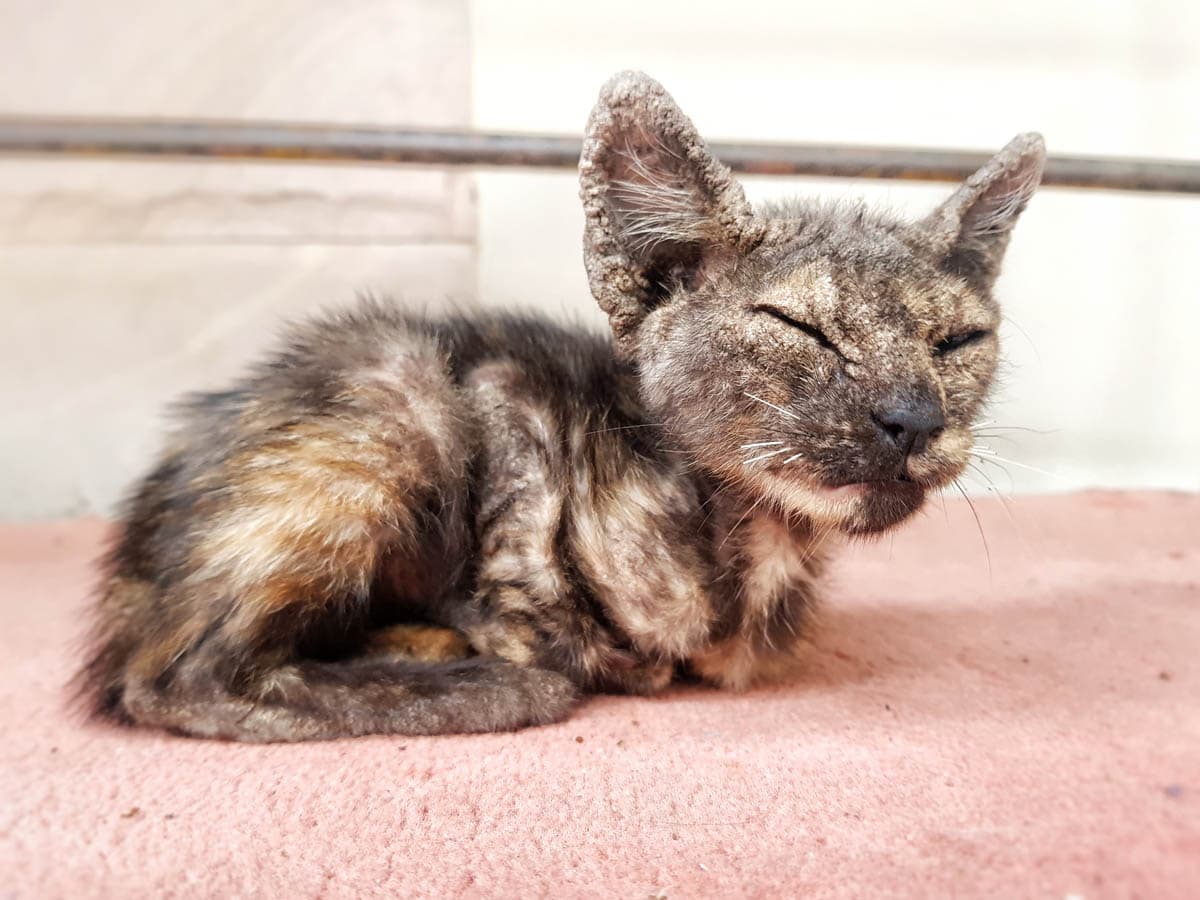Overview
Scabs are rough protective crusts that form over a wound to the skin as it heals which can develop on any part of the skin. The location, type, number, size, and appearance of the scabs can help your veterinarian during evaluation and diagnosis.
Causes
There are many possible causes of scabs on cats which go beyond the scope of this article. We look at the top five most common causes of scabs in cats.
Flea allergy dermatitis
The most common cause of scabs on cats, caused by an allergic reaction to flea saliva. Multiple, small, hard and crusty scabs (miliary dermatitis) can develop on the cat’s back which has a grit-like feel and around the neck. The skin is itchy, which causes the cat to scratch and damage the area. It is not uncommon for open wounds to develop on the neck as a result of self-inflicted trauma.
Treatment:
Diligent flea control with a veterinary-approved treatment. 90% of the flea life cycle is off the cat, in the environment, it is important to treat the home as well as the cat. The most popular and effective flea treatments come in the form of topical (spot-on) products which are applied to the back of the cat’s neck.
In addition to the above treatments, omega fatty acids, shampoos, antihistamines, and corticosteroids can provide symptomatic relief.
Ringworm
A common and highly infectious fungal infection that affects the skin and hair of cats. Circular lesions can develop on any part of the body. Kittens and cats with underlying disease and cats in over-crowded environments (such as shelters) are most at risk.
Treatment:
Medicated shampoos and dips are the most common treatment. It will also be necessary to decontaminate the house. Wash the cat’s bedding in hot water and hang outside in the sun to dry. Wipe down surfaces with a 10% bleach solution.
Food allergies
Food allergies are the second most common type of allergy in cats. Cats become allergic to foods they have eaten for a long period of time (usually two years or more).
The most common symptoms of food allergies are vomiting and non-seasonal itching with areas of thinning hair or hair loss, and scabs that form due to constant scratching. The head, face, neck, and ears are the most commonly affected areas.
Treatment:
Switch to a hypoallergenic diet or a novel protein such as kangaroo or duck.
Corticosteroids and antihistamines can be prescribed to relieve symptoms associated with itching.
Feline acne
A common skin disorder that affects the chin of cats. Small blackheads form which can have the appearance of dirt. The area becomes itchy and inflamed, eventually causing crusting lesions. There are a number of possible causes which include the use of plastic food bowls, food allergies, hormones, viral infections, excessive chin rubbing. In many cases, the underlying cause is never found.
Treatment:
Switch to ceramic, glass or stainless steel food bowls. Clean the affected area twice a day with witch hazel. If the acne is severe, your veterinarian can prescribe a medicated cleansers and antibiotics.
Ear edge dermatitis
The ears are susceptible to a number of disorders which present as scabs, these include sunburn, ear mites, systemic lupus erythematosus, pemphigus, allergies, squamous cell carcinoma, mange, demodicosis. Crusting, scabbing, hair loss and in some cases, itching.
Treatment:
This will depend on the underlying cause. SLE and pemphigus are immune-mediated disorders, which means the cat’s own immune system attacks tissues within the body. Immunosuppressive therapy is the mainstay of treatment for these conditions. Parasites such as mites and mange are treated with appropriate anti-parasitic medication, shampoo or dip. Avoidance of known allergens is the goal of treatment for cats with allergies. Corticosteroids and antihistamines may also be prescribed. Surgery to remove squamous cell carcinoma. As sunburn can eventually become cancerous, avoid sun exposure in pale cats.
Diagnosis
In some cases, the cause can be diagnosed during the physical examination. Scabs on the neck and back suggest cat fleas, non-seasonal itching, hair loss and scabs on the face are often associated with allergies. Circular patches of hair-loss are common findings in ringworm.
Diagnostic workup:
- Skin scraping test – A sample of skin is scraped using a sharp blade to look for the presence of mites.
- Fungal culture – A sample skin and/or fur is placed on a culture medium and stored in a dark place to encourage fungal growth. This is a useful diagnostic for ringworm.
- Woods lamp examination – A black light is used to look for ringworm on the skin and fur which will glow a fluorescent green. Only 50% of ringworm strains will glow.
- Cytology – A sample from the sore or scab is taken and the cells are examined under a microscope. This can help to diagnose fungal, yeast and bacterial infections.
- Food elimination trials – The cat is placed on a novel protein to see if symptoms improve. If they do, the cat is then re-introduced to its normal diet to see if symptoms return.
- Intradermal skin testing – A minute amount of a number of common allergens are injected into the skin to evaluate for allergies.
- Fine needle aspiration or biopsy – A sample of skin, growths or lesions is removed and evaluated under a microscope.
Frequently asked questionsWhy does my cat have scabs on its neck and back? The most common cause of scabs on the neck and back of a cat is due to flea allergy dermatitis Do flea bites leave scabs on cats? The actual bite from a flea is minute, however in the cat with flea allergy dermatitis, a local response develops which leads to swelling, itching, scratching and scabs. Is it safe to use Neosporin on a cat? No, Neosporin contains Polymyxin B which has been known to cause anaphylaxis in cats. Read here for antiseptics safe to use on cats. |

